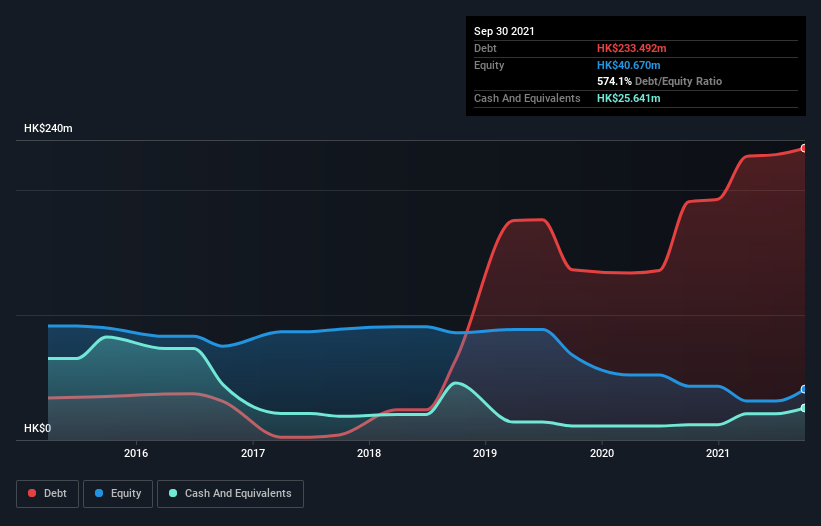- Hong Kong
- /
- Paper and Forestry Products
- /
- SEHK:8277
Here's Why Steed Oriental (Holdings) (HKG:8277) Is Weighed Down By Its Debt Load

Legendary fund manager Li Lu (who Charlie Munger backed) once said, 'The biggest investment risk is not the volatility of prices, but whether you will suffer a permanent loss of capital.' So it seems the smart money knows that debt - which is usually involved in bankruptcies - is a very important factor, when you assess how risky a company is. We can see that Steed Oriental (Holdings) Company Limited (HKG:8277) does use debt in its business. But should shareholders be worried about its use of debt?
When Is Debt A Problem?
Generally speaking, debt only becomes a real problem when a company can't easily pay it off, either by raising capital or with its own cash flow. Ultimately, if the company can't fulfill its legal obligations to repay debt, shareholders could walk away with nothing. While that is not too common, we often do see indebted companies permanently diluting shareholders because lenders force them to raise capital at a distressed price. Of course, the upside of debt is that it often represents cheap capital, especially when it replaces dilution in a company with the ability to reinvest at high rates of return. The first step when considering a company's debt levels is to consider its cash and debt together.
Check out our latest analysis for Steed Oriental (Holdings)
What Is Steed Oriental (Holdings)'s Debt?
As you can see below, at the end of September 2021, Steed Oriental (Holdings) had HK$233.5m of debt, up from HK$190.6m a year ago. Click the image for more detail. On the flip side, it has HK$25.6m in cash leading to net debt of about HK$207.9m.

A Look At Steed Oriental (Holdings)'s Liabilities
The latest balance sheet data shows that Steed Oriental (Holdings) had liabilities of HK$90.9m due within a year, and liabilities of HK$287.8m falling due after that. On the other hand, it had cash of HK$25.6m and HK$42.4m worth of receivables due within a year. So its liabilities outweigh the sum of its cash and (near-term) receivables by HK$310.7m.
This deficit casts a shadow over the HK$56.7m company, like a colossus towering over mere mortals. So we definitely think shareholders need to watch this one closely. After all, Steed Oriental (Holdings) would likely require a major re-capitalisation if it had to pay its creditors today.
We use two main ratios to inform us about debt levels relative to earnings. The first is net debt divided by earnings before interest, tax, depreciation, and amortization (EBITDA), while the second is how many times its earnings before interest and tax (EBIT) covers its interest expense (or its interest cover, for short). This way, we consider both the absolute quantum of the debt, as well as the interest rates paid on it.
Weak interest cover of 0.035 times and a disturbingly high net debt to EBITDA ratio of 14.8 hit our confidence in Steed Oriental (Holdings) like a one-two punch to the gut. This means we'd consider it to have a heavy debt load. Even worse, Steed Oriental (Holdings) saw its EBIT tank 67% over the last 12 months. If earnings continue to follow that trajectory, paying off that debt load will be harder than convincing us to run a marathon in the rain. When analysing debt levels, the balance sheet is the obvious place to start. But it is Steed Oriental (Holdings)'s earnings that will influence how the balance sheet holds up in the future. So if you're keen to discover more about its earnings, it might be worth checking out this graph of its long term earnings trend.
But our final consideration is also important, because a company cannot pay debt with paper profits; it needs cold hard cash. So the logical step is to look at the proportion of that EBIT that is matched by actual free cash flow. During the last two years, Steed Oriental (Holdings) burned a lot of cash. While that may be a result of expenditure for growth, it does make the debt far more risky.
Our View
To be frank both Steed Oriental (Holdings)'s EBIT growth rate and its track record of staying on top of its total liabilities make us rather uncomfortable with its debt levels. And even its interest cover fails to inspire much confidence. Considering everything we've mentioned above, it's fair to say that Steed Oriental (Holdings) is carrying heavy debt load. If you play with fire you risk getting burnt, so we'd probably give this stock a wide berth. The balance sheet is clearly the area to focus on when you are analysing debt. However, not all investment risk resides within the balance sheet - far from it. For example, we've discovered 4 warning signs for Steed Oriental (Holdings) (2 are a bit unpleasant!) that you should be aware of before investing here.
If, after all that, you're more interested in a fast growing company with a rock-solid balance sheet, then check out our list of net cash growth stocks without delay.
New: Manage All Your Stock Portfolios in One Place
We've created the ultimate portfolio companion for stock investors, and it's free.
• Connect an unlimited number of Portfolios and see your total in one currency
• Be alerted to new Warning Signs or Risks via email or mobile
• Track the Fair Value of your stocks
This article by Simply Wall St is general in nature. We provide commentary based on historical data and analyst forecasts only using an unbiased methodology and our articles are not intended to be financial advice. It does not constitute a recommendation to buy or sell any stock, and does not take account of your objectives, or your financial situation. We aim to bring you long-term focused analysis driven by fundamental data. Note that our analysis may not factor in the latest price-sensitive company announcements or qualitative material. Simply Wall St has no position in any stocks mentioned.
Have feedback on this article? Concerned about the content? Get in touch with us directly. Alternatively, email editorial-team (at) simplywallst.com.
About SEHK:8277
Steed Oriental (Holdings)
An investment holding company, sources, manufactures, and sells wooden products in Mainland China.
Moderate and slightly overvalued.
Market Insights
Community Narratives



